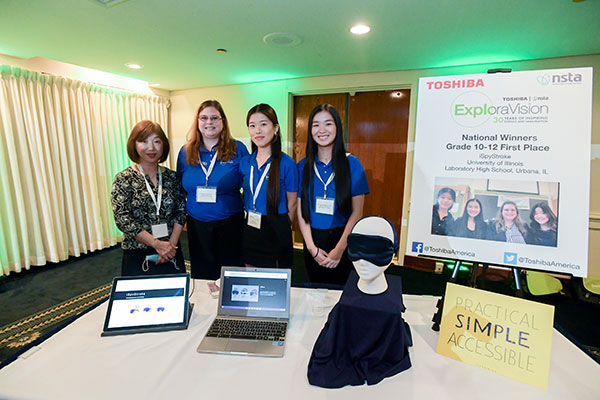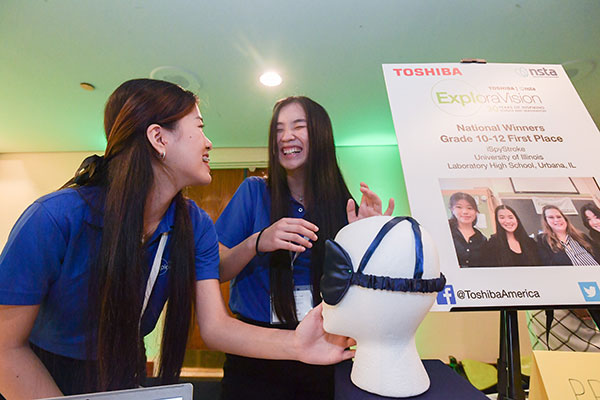Next-Gen: Imagination-Fueled Problem-Solving
Student Competition Profile: Toshiba ExploraVision STEM Competition

Toshiba ExploraVision is a science/STEM competition for students in kindergarten through senior year of high school. Images courtesy of Jim Romeo and Toshiba.
Latest News
March 28, 2024
Toshiba ExploraVision is a science/STEM competition for students in kindergarten through 12th grade. It engages the next generation in real-world problem-solving with a strong emphasis on science, technology, engineering and mathematics (STEM).
Toshiba ExploraVision challenges student teams to envision and communicate new technology for 10+ years in the future through brainstorming and researching current science and technology developments. It simulates real, scientific and technological research and development through collaborative brainstorming, researching and exploring technologies of interest. The competition is sponsored by Toshiba and administered by the National Science Teaching Association (NSTA).
Jessica Knight is an account executive with PAN Communications and a spokesperson for ExploraVision and Toshiba. We spoke to her to learn more about this competition. Here’s our conversation.
Digital Engineering: Can you provide an overview of the competition, how it came to be, and the intent of the program?
Jessica Knight: The ExploraVision competition began in 1992. Due to Toshiba’s commitment to fostering young students’ interest in STEM, Toshiba partnered with NSTA to help administer the competition.
The intent of Toshiba ExploraVision is twofold: to help young kids expand their imagination at a critical early stage, and to offer more mature students a skill-learning experience in critical thinking and problem-solving that is central to the Next Generation Science Standards.
ExploraVision is also based on the engineering design process, which engages students to think like an engineer, teaching students to consider technology’s positive and negative consequences. It is a STEM competition that allows for children to participate in an inquiry-based, hands-on scientific learning experience designed specifically for students.
Students participate in teams of two to four [youth, along] with one teacher or coach and one optional mentor. Participants must be enrolled full time in public, private or home[-based] school.
Toshiba ExploraVision has had 431.5 thousand student participants with a total of 133.2 thousand entries. On average, the competition receives 5,000 team project entries and engages about 20,000 student participants annually.
We welcome students from the United States and Canada between kindergarten and senior year of high school [who do not] exceed 21 years old. Except for the age and location criteria, this competition is open to students of all races, sexes, gender identities, sexual orientations, abilities and interests.
DE: Can you tell us about some of the designs that are part of the event and how they came to be?
Knight: Toshiba ExploraVision is a unique science and STEM competition that encourages students to think outside the box. Teams identify a problem that current technology does not solve and imagine possible solutions. They gain inspiration through events they’ve experienced, personal interests or more.
For example, the winning project in 2022 in the high school age group was called iSpyStoke, a sleeping mask designed to detect wake up strokes and alert medical professionals and emergency contacts through a connected app.
In 2021, the winning project in the upper elementary age group was a Coagulation Filtration System, a safe, efficient and sustainable approach to water filtration aimed at providing safe drinking water through solar-powered technology.
The upper elementary age group winners in 2023 created PetConnect, an app that uses artificial intelligence (AI) to understand and translate sounds and behaviors from dogs and cats. As the AI model learns more about the pet, the app produces more accurate translations over time, helping pet owners better understand their pet’s needs.

Additionally, the 2023 winners in the middle school age group created Fungi Fabrics, an eco-friendly clothing material made from mushroom roots, called mycelium. This project also addresses landfill waste caused by clothing, as the mycelium fabric can be disposed of in soil or water.
DE: Can you provide some examples of what the event has produced or what you expect it to produce?
Knight: Toshiba ExploraVision is more than just a science competition. Participating student teams go above and beyond to think critically and creatively about the biggest problems facing the world, from healthcare challenges to sustainability efforts to energy efficiency and more.
Toshiba ExploraVision alumni have pursued higher education and earned their master’s and doctorate degrees, are practicing medical doctors, are company co-founders, [are] university professors, work in a variety of engineering fields, and more.
For example, one 1993 alum earned his Ph.D. in aeronautics and astronautics and now serves as the engineering director of high-level motion planning at autonomous driving tech company, Waymo. One 1998 alum, who earned his Ph.D. in applied physics, says that Toshiba ExploraVision helped him develop a toolbox for answering important questions and effectively communicating results.
DE: Does Toshiba have a particular stance on adopting an innovation that is linked to the program? What drove them to sponsor the event and coordinate it?
Knight: “Committed to People, Committed to the Future” is Toshiba’s guiding management philosophy. To solve social issues and reduce the information gap, Toshiba is committed to enhancing the quality of life for people around the world, and at its core is fostering young people’s interest in STEM.
To do this, the company contributes to the realization of a data-connected society, one that works to conserve the global environment and solve issues like equality and education. Toshiba’s innovations have led to the development of cutting-edge technology in the U.S. designed to promote the importance of a STEM education—as early as kindergarten—to allow all students to dream big and think outside the box.
This dedication to education and innovation is what led Toshiba to partner with NSTA to create ExploraVision in 1992, creating a science competition open to not just high school [students], but to kindergarten [and] middle school [students] and everyone in between. Through this competition, children have expanded their imagination while developing an interest in STEM education at an early age, and thus helping to combat the world’s social issues through their ExploraVision projects.
Subscribe to our FREE magazine, FREE email newsletters or both!
Latest News
About the Author
Jim Romeo is a freelance writer based in Chesapeake, VA. Send e-mail about this article to DE-Editors@digitaleng.news.
Follow DERelated Topics






